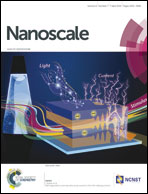Novel synthetic methodology for controlling the orientation of zinc oxide nanowires grown on silicon oxide substrates†
Abstract
This study presents a simple method to reproducibly obtain well-aligned vertical ZnO nanowire arrays on silicon oxide (SiOx) substrates using seed crystals made from a mixture of ammonium hydroxide (NH4OH) and zinc acetate (Zn(O2CCH3)2) solution. In comparison, high levels of OH− concentration obtained using NaOH or KOH solutions lead to incorporation of Na or K atoms into the seed crystals, destroying the c-axis alignment of the seeds and resulting in the growth of misaligned nanowires. The use of NH4OH eliminates the metallic impurities and ensures aligned nanowire growth in a wide range of OH− concentrations in the seed solution. The difference of crystalline orientations between NH4OH- and NaOH-based seeds is directly observed by lattice-resolved images and electron diffraction patterns using a transmission electron microscope (TEM). This study obviously suggests that metallic impurities incorporated into the ZnO nanocrystal seeds are one of the factors that generates the misaligned ZnO nanowires. This method also enables the use of silicon oxide substrates for the growth of vertically aligned nanowires, making ZnO nanostructures compatible with widely used silicon fabrication technology.


 Please wait while we load your content...
Please wait while we load your content...